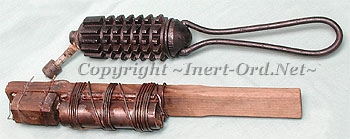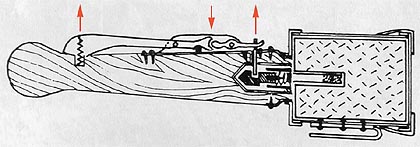
 1914-1917
1914-1917On the eve of the Great War grenade technology was at a primitive level. The classic cast iron sphere was little changed from its 17th century inception.
As the trench war progressed distances between opposing forces became ever smaller, the ability to attack your opponent without the requirement of direct line of site was a great advantage. Hand grenades became an indispensable weapon and development proceeded at a furious pace.
Early designs ranged from simple ball grenades such as the Kugel to complex types such as the Austrian Universal. Stick grenade types became increasingly popular and appeared in a bewildering variety of styles.
Shown here are the improvised French Pétards Raquettes, and an Austrian rifle grenade reconfigured as a stick grenade.
Time fuze technology was crude and delay times needed to be at least five to seven seconds for safety reasons. However, when thrown at short range, there was too often time enough remaining on a burning fuze to allow a soldier to pick up and throw the grenade back. A fuze that would explode on impact was highly desirable and many designs were tried, but few (if any) achieved any significant degree of success.
By 1915 the Germans introduced their first regulation stick grenades, with the now familiar metal can of explosive attached to a stick handle, equipped with delay fuze activated by a pull cord lanyard. By 1916 German stick grenade production alone was eight million per month! At least 20 different stick grenade designs and variations were fielded by Germany from 1914 to 1917.


